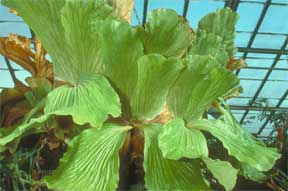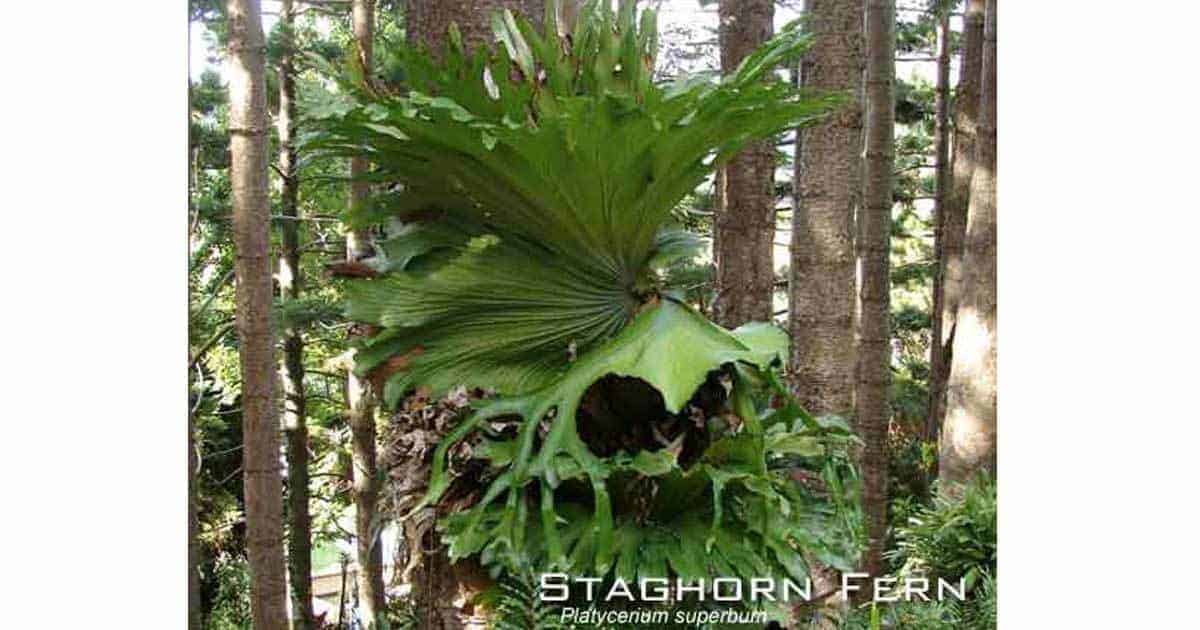Staghorn Ferns could be an excellent choice for your garden. Do you have:
- A suitable environment like a backyard greenhouse or enclosed porch?
- An area with bright indirect light, high humidity, and temperatures between 60-80°F.
Platycerium are unique, attractive and versatile plants growing well in hanging baskets, on wood mounts, or even as houseplants, making them adaptable to various garden setups. However, they require specific care including proper watering and fertilizing.
Looking to grow something unusual, a true conversation piece… learn more below on caring for Staghorn fern plants.

Except for Platycerium andinum, native to South America, the genus Platycerium, comprises about 18 species, all found in natural tropical and temperate regions of Africa, Southeast Asia, the Philippines, Australia, and New Guinea.
When first learning staghorn fern care, note how the staghorn grows in the wild, almost like air plants. They attach themselves to tree trunks living as epiphytes earning the term epiphytic ferns.

This makes them outstanding subjects, which best grow as a decorative hanging plant. They can be grown in pots, but like the rabbit’s foot fern, they attain their true distinctive looks and beauty when grown as a hanging specimen.

An attractive display can be “created” in a greenhouse or protected area if plants (singular or multiple) are attached to a tree trunk as stand-alone specimens.
You may like Dicksonia Antarctica, aka Tasmanian Tree Fern
Platycerium Bifurcatum Quick Care Tips
- Botanical Name: Platycerium bifurcatum
- Common Name(s): Staghorn Fern
- Synonyms: Elkhorn Fern
- Pronunciation: plat-ih-SEER-ee-um bye-fur-KAY-tum
- Family & Origin: Polypodiaceae, native to South America, Africa, Southeast Asia, the Philippines, Australia, and New Guinea
- Growability: Easy to moderate
- Grow Zone: 9-12
- Size: Can grow up to 2 feet to 3 feet
- Flowering: Does not produce flowers
- Light: Bright, indirect light
- Humidity: High humidity, mist regularly
- Temperature: Prefers temperatures between 60-80°F
- Soil: Well-draining soil, such as a mixture of peat moss and perlite
- Water: Water by submerging the entire root system in water
- Fertilizer: Fertilize with liquid plant food during the growing season (spring and summer)
- Pests & Diseases: Susceptible to Aphids and scale insects, It can also develop root rot if overwatered
- Propagation: Can be propagated by seeds, spores, or by dividing the plant
- Plant Uses: Can be grown as a houseplant or mounted on a board or tree in a garden setting. Adds a unique and tropical touch to any space.
- Platycerium Bifurcatum Quick Care Tips
- Staghorn Plant Leaves – Fronds of Two Types
- How To Care For A Staghorn Fern
- Different Methods for Growing Staghorn Plants
- Staghorn Fern Propagation
- Platycerium Staghorn Fern Species
- Fertilizing Staghorn Ferns
- Pests and Problems Of Staghorn Ferns
- Staghorn Fern Buying Tips
Staghorn Plant Leaves – Fronds of Two Types
These ferns have two kinds of leaves (fronds): sterile shield frons, which usually are rounded in outline, and fertile fronds, which are forked like the antlers of a reindeer. Both fronds are covered with sort of a gray furry down.

Fertile Fronds
It is on the fertile, forked fronds (some species are held erect, and others are drooping) that the spores are produced.
The clusters of spores are visible as a large brown deposit formed in masses on the underside of the leaves, usually towards the tips of the lobes. The spores are the reproductive bodies.
Sterile Shield Staghorn Fronds
The sterile fronds also have important functions. They are at first green and succulent but ultimately lose their moisture and become cinnamon-colored and parchment-like.
In their early stage, in addition to performing the usual function of green leaves, they help to attach the plant to its support.
Later the usually flaring tops hold leaves and other debris which have fallen from the trees above and ultimately decay and form humus from which the fern roots collect nutrients.
Related: Growing The Cinnamon Fern
Staghorn Fern Basics Video
How To Care For A Staghorn Fern
Over the years, I’ve grown many Platycerium fern species successfully by providing four conditions for successful growth.
#1 – Stag horns do not like direct sunshine but need bright indirect light for the best growth. Look for a location that can provide and good 4-7 hours of bright, direct sunlight daily. They are also winter hardy to USDA Zone 9-12.
#2 – These plants come from tropical areas of Southeast Asia, the Philippines, Australia, and Africa, with high humidity. Try to grow plants in high-humidity locations with good air circulation. Do not mist the plant to maintain humidity.

Watering is best done (if possible) by submerging the entire root system in water. Water weekly in the summer and once every ten days in the winter; soaking for fifteen minutes is enough.
Add liquid plant food, rich in nitrogen, every 3rd watering during the growing season (spring and summer).
#3 – Again, pay attention to where these plants are native to. During the winter, plants should not be exposed to temperatures below 55° degrees Fahrenheit.
#4 – Stag ferns in their native habitat grow on trees. They can be grown in very rich but porous soil (often sold this way at garden centers), but I generally do not recommend soil as a growing medium.
However, the best results I’ve encountered are not growing in soil but planting or mounting platyceriums on a moist bed of sphagnum moss and fertilizing every other week using a complete (20-20-20) liquid plant fertilizer program.

Different Methods for Growing Staghorn Plants
As we said in point #4, stags can be grown in pots.
I’ve witnessed stag horn plants thriving in clay or plastic pots, using pure peat moss as the “growing medium” when good drainage is present. Repotting is only required when the plant outgrows the pot.
The real beauty of the staghorn fern shines when the plant is grown on a piece of wood, in a hanging basket or box like those used for orchids, then displayed hanging as a stand-alone specimen.

The basket or box is usually lined with sphagnum moss, and the fern and its root ball are planted directly in the moss with a fishing line. Other times sphagnum moss is used as the potting mix and lines the basket, and the fern is planted in a well-draining, rich soil.
Staghorn ferns can also be grown on a tree stump, “plaque,” or piece of plywood where the fern is mounted on a bed of sphagnum moss and wired in place.
Here’s a Video on Planting a Staghorn in a Basket
Grooming
Staghorn ferns don’t require grooming, but old withered “fertile” leaves should be removed. The sheath-shaped “sterile” leaves should be removed when they fall off if lightly touched.
Related: Ferns and other indoor plants for the Bathroom
Staghorn Fern Propagation
Staghorns can be propagated in several ways – side shoots, sometimes called “pups,” or spores. The easiest, most common, and most popular method is from side shoots.
Side Shoots or “Pups”
Staghorn fern pups emerge from the base of the mother plant. Before removing “pups” from the mother plant, they must have already formed and developed a root system. Small pups can be planted in pots in pure peat moss.
Larger pups can be planted in a basket of sphagnum moss or mounted on a wood plaque on top of a bed of sphagnum.
Video: Dividing Pups and Staghorn Fern Mounting
Growing Staghorn Ferns From Spores
Ferns do not flower or grow from seeds but propagate from spores. Spores are those brown deposits on the underside of the antler-like leaves.
September to December are good months for sowing spores.
As the fern spores are carefully removed, sow them in clean, wet sphagnum (some cover the sphagnum with a thin layer of sand). I like to use clear sweater boxes.
Take a piece of glass, cover the propagating tray, and place it somewhere dark, keeping temperatures around 78 degrees.
When new plants appear and have formed leaves, plant the young plants into small pots using a well-draining starter mix (like 50%/50% peat moss/perlite).
Fertilize once per week with a liquid plant food at 1/4 strength.
Video on Growing Ferns From Spores
Platycerium Staghorn Fern Species
Staghorn ferns (playceriums), also called elkhorn ferns, of which about 18 species can grow to become very old and are not difficult to grow.
The leaves come in a variety of sizes and shapes. Fertile fronds can grow 2 – 3 feet in length.
- Platycerium andinum
- Platycerium alcicorne
- Platycerium bifurcatum
- Platycerium coronarium
- Platycerium elephantotis
- Platycerium ellisii
- Platycerium grande
- Platycerium hillii
- Platycerium holttumii
- Platycerium madagascariense
- Platycerium quadridichotomum
- Platycerium ridleyi
- Platycerium stemaria
- Platycerium superbum
- Platycerium veitchii
- Platycerium wallichii
- Platycerium wandae
- Platycerium willinkii
Fertilizing Staghorn Ferns
Stag horn ferns of nature get ample nutrients from their surroundings. On the other hand, those living indoors or in an urban setting rely on a thin amount of resources.
Many throw their banana peels on the top of the fern. Due to this, you may need to apply staghorn fern fertilizers to ensure the growth and health of your mount staghorn fern plants.

Like most plants, elkhorn fern requires feeding during the active growing season. The best food for them is water-soluble fertilizers.
Pests and Problems Of Staghorn Ferns
Pests: Staghorn ferns are not attacked by many pests. If pest problems occur, it is often due to improper.
Aphids and scale insects can be removed by careful spraying with an approved insecticide – try natural first. Repeat treatments may be required.
I would never add any type of wetting agent, surfactant or sprayer stickers into the spray mix, they can clog the “pores” and damage the plant.
Problems: Droopy leaves are usually a result of insufficient water. DO NOT wipe off leaves even though they look dusty, as the fronds have a furry gray down, which helps slow transpiration.
Staghorn Fern Buying Tips
If you can grow orchids and bromeliads, you can grow Staghorns. Before purchasing any Platycerium, ensure you have a suitable spot to grow it. It can be bought at any time of the year.
Depending on the species, the “sterile leaves” may be papery and brown, but the Staghorn’s fertile leaves should be free of damage and the furry gray down intact.
